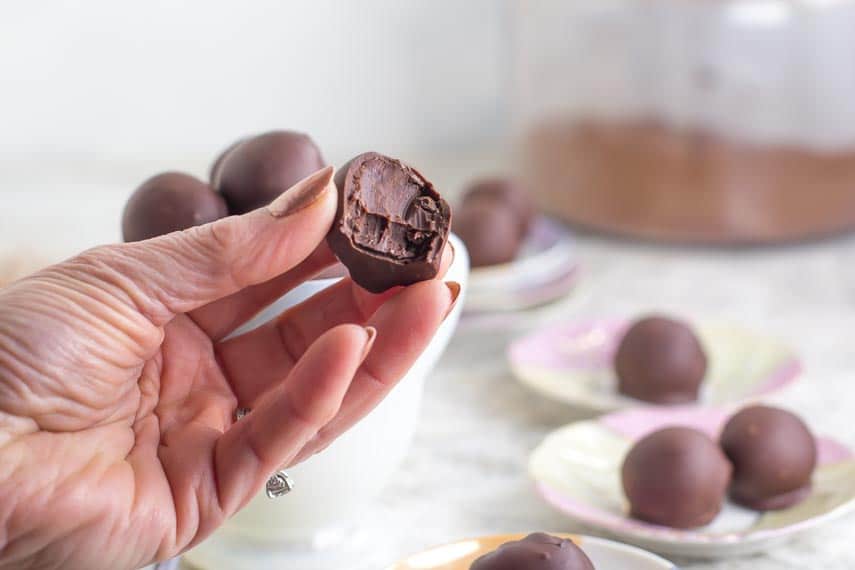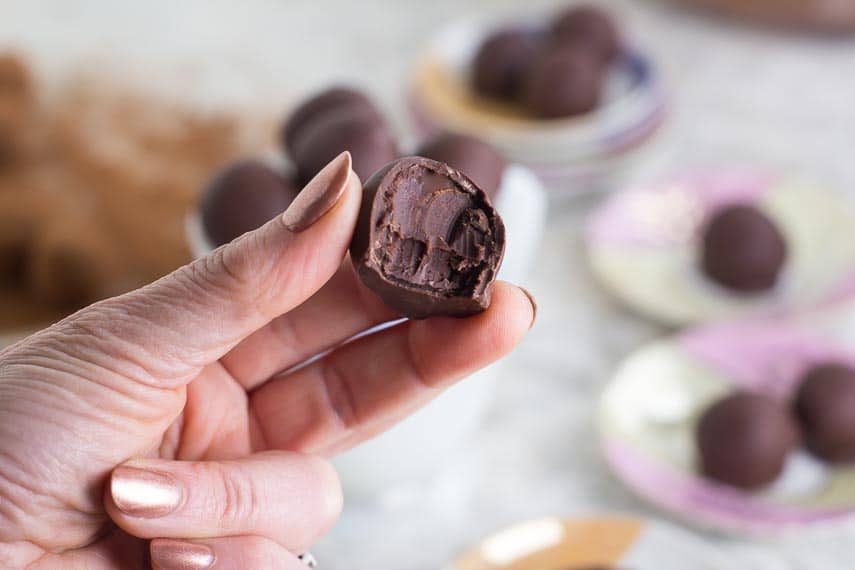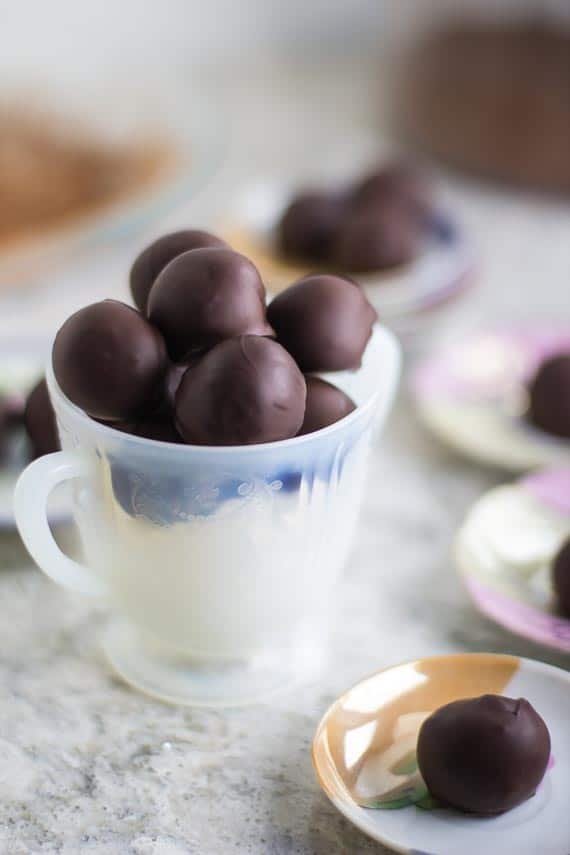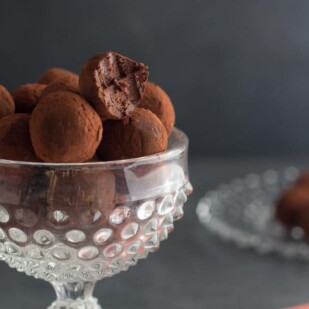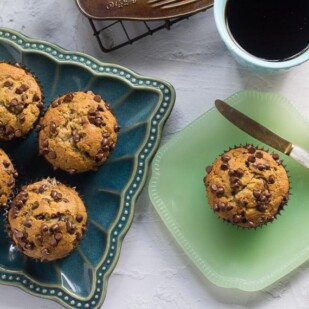Yes, you can enjoy truffles on the low FODMAP diet, and we can’t think of a more direct way to enjoy dark chocolate than with a couple of our Low FODMAP Chocolate Dipped Truffles. These truffles are rich and dark through and through from a silky ganache center to their crisp outer chocolate shell. For an easier version, check out our cocoa dusted Low FODMAP Dark Chocolate Truffles; these are a little fancier and require tempering.
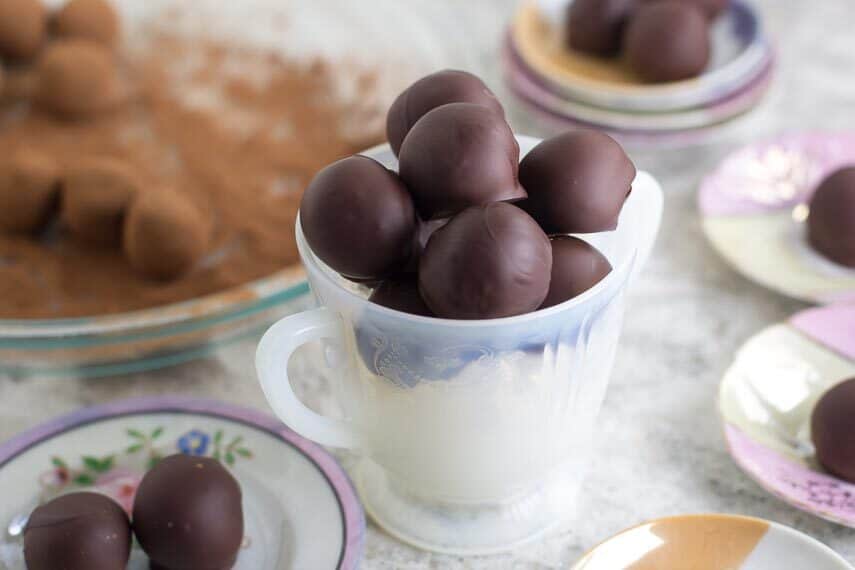
Yes, Monash University has lab tested two kinds of dark chocolate and they have low FODMAP amounts: 85% dark is low FODMAP at 20 g and what they call “dark” is low at 30 g. Note that their “dark” sample contained dairy.
If you are a chocolate fan, and we assume you are, you will enjoy these articles:
All About Dark Chocolate & FODMAPs
All About Milk Chocolate & FODMAPs
All About White Chocolate & FODMAPs
All About Cocoa & FODMAPs
These truffles are all about dark chocolate. Do not try to make these by melting down supermarket chocolate chips. Chips are formulated to hold their shape and should never be used for melting – and they are definitely the worse thing to use to create a thin shell for truffles. This is because they have a high (gloppy) viscosity which is the opposite of what you want for enrobing.
Here are some chocolates that I like for this recipe:
Scharffen Berger Bittersweet chocolate 70% and Semisweet chocolate 62%.
Valrhona – Try the bittersweet Caraibe 66% and Extra Bitter 61%. I also love the Manjari 64%, Equatoriale 55% and Tainori 64%.
The Guanaja 70% and Araguani 72% are fantastic bittersweet chocolates that I often use to coat truffles (for the exterior shell) even if a different chocolate is used for the centers.
Guittard – Try the Organic Dark 66%, Etoile du Nord 64% and Lever du Soleil 61%.
For Callebaut try their Recipe° 2815 57.7%. I like Callebaut, but many of their chocolates are too thick for easy enrobing, in my opinion and it is difficult for the home-maker to get their hands on the right formulas in small quantities.
For a supermarket choice, try Lindt Excellence Bar 70% (often found in the candy aisle, not the baking aisle). If has a pretty good flavor and a thin viscosity.
Great question! You can or do what I do and use a lower cacao percentage for the ganache and a higher, more fluid chocolate for the shell. I love combining Valrhona Extra Bitter 61% for the ganache with Valrhona Guanaja 70% for the shell.
The ganache will work best with a maximum 65% cacao mass. For the shell you can go as high a cacao percentage as you like.
Tempering is simply melting chocolate in a way that controls the temperature, so that the fat crystals are stabilized as the chocolate cools. After cooling, tempered chocolate will be thin, glossy and crisp. Tempered chocolate will add a polished look to your candies – literally and in the figurative sense in that they will be like the ones professional chocolatiers make!
Begin with a high cocoa butter chocolate, typically labeled as couverture, for best results and make sure the chocolate you are using is in good temper itself. It should be shiny, free of any streaks or mottling and it should snap when you break it. A chocolate thermometer (one that measures one-degree increments from 40°F to 130°F/4°C to 55°C) is required for best results.
Also, FYI, it is easier to work with the amount of chocolate that we call for in the recipe rather than a smaller amount. The amount listed below allows you to truly dip your truffles down into the tempered chocolate. It also means there will be some chocolate leftover. Just pour it out onto a piece of foil, let it harden, then chop it up to use later in recipes that call for melted chocolate, or use as chunks for cookies.
The instructions below are for a full tempering process. There are shortcuts, but they often provide results that lack the finesse of classically tempered chocolate.
I can! One of my books, Truffles, is completely dedicated to making chocolate truffles: dark, milk and white chocolate. Champagne Truffles; Truffles with fruit like Raspberry. Molded Truffles, Light Whipped Ganache Truffles, Nondairy Naturally Sweetened Truffles, Cranberry White Chocolate Truffles, Toasted Coconut Truffles, Fresh Mint Truffles (50 total) – all of those listed are low FODMAP, by the way, and you will find much, much more. Tips on technique, chocolate buying, equipment, troubleshooting, etc.
It is and we discuss this at length in our article, All About Cream & FODMAPs. It is a matter of serving size.
You can have up to ¼ cup (60 ml). The article linked above explains this math, which is different from what is on the Monash app (unless you dig, which we did).
You might also like reading our article, High FODMAP Foods With Low FODMAP Serving Sizes.
How To Make Low FODMAP Chocolate Dipped Truffles
Make the Ganache: Place cream in a large saucepan and heat over medium heat until cream just comes to a simmer. Remove from heat and immediately stir 1-pound (455 g) chocolate into the hot cream. Cover the pot and allow to sit for 5 minutes; the heat should melt the chocolate. Stir very gently until smooth, but so not whisk, which would add air.
Pour mixture into a shallow bowl (I use a pie plate); cover with plastic wrap and allow to cool at room temperature, preferably overnight, or until firm enough to roll. You may refrigerate this ganache until it is firm enough to roll, about 4 hours, to hasten the process. This is your ganache center mixture.
Coat your hands lightly with cocoa and roll chocolate ganache mixture into 3/4-inch to 1-inch (2 cm to 2.5 cm) balls, making them as round as possible.
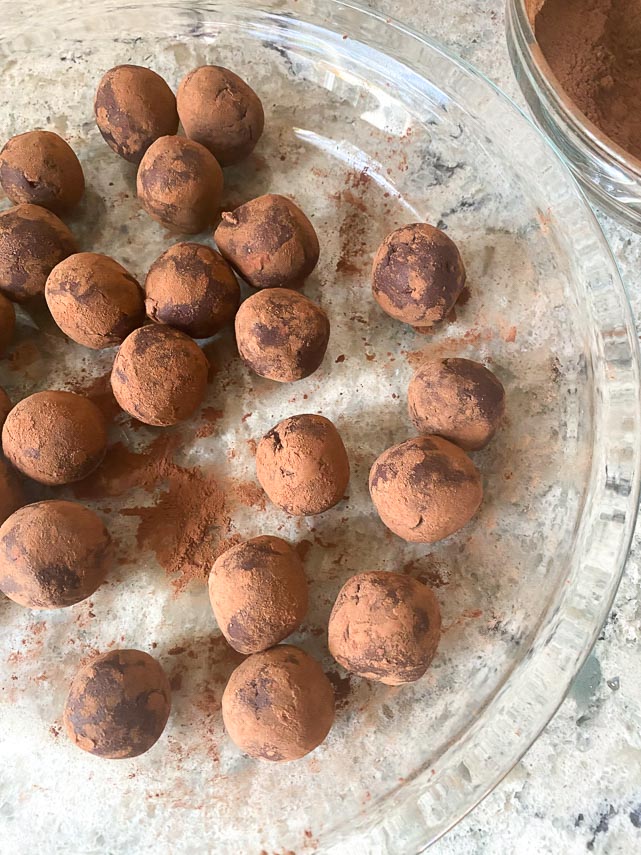
I like to use a small truffle scoop to facilitate. Chill in a covered container while you temper the remaining chocolate.
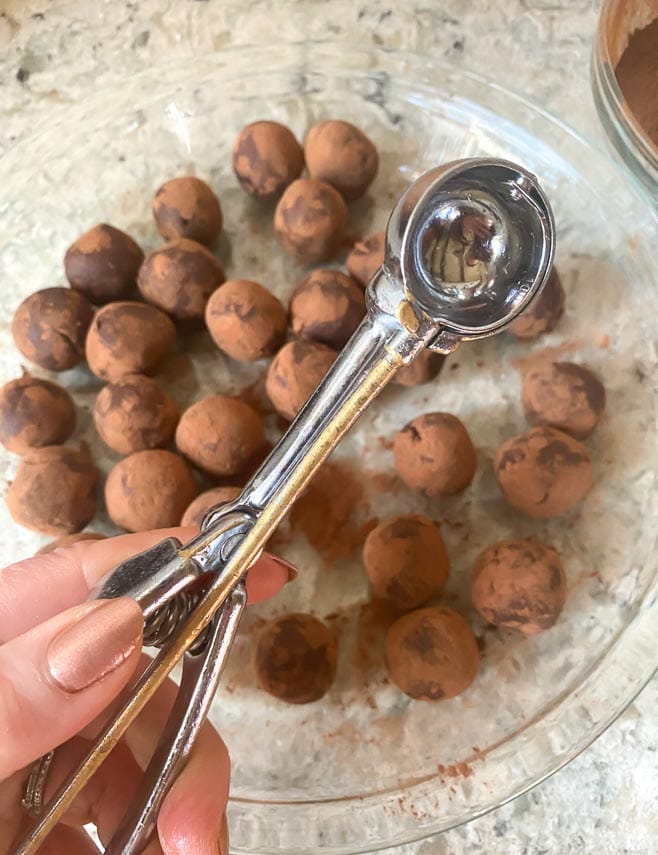
Temper the Remaining Chocolate: Line two rimmed half-sheet pan with aluminum foil, shiny side up, smoothing out any wrinkles.
Place about two-thirds of the remaining 1-pound (455 g) chocolate in the top of a double boiler with gently simmering water in the lower half of the double boiler. Stir gently to encourage melting, but not vigorously, which will add air. Do not allow chocolate to heat above 115°F (45°C) for. As soon as the chocolate is almost completely melted, remove from the heat and wipe the bottom of the pot to eliminate any chances of water droplets reaching the chocolate, which would cause it to seize.
Add about one-third of the remaining chopped chocolate and stir gently. The residual heat will melt it. You want to cool the chocolate down to 79°F (26°C). Keep adding the remaining chocolate, in a few more stages, if necessary, to cool chocolate further, continuing to stir gently until 79°F (26°C) is reached. Any un-melted chocolate can be removed and reserved for another use.
Place pot back over hot, not simmering water, and re-warm gently. Bring chocolate back up to 88°F to 90°F (31°C to 32°C). Do not allow any chocolate to rise above 90°F (32°C) or you will have to begin the entire tempering process again. Occasionally chocolate labels will tell you what their specific tempering temperature is, so heed their advice. The chocolate is now ready to use.
Test The Temper
To test the temper, thinly spread a teaspoon amount on a piece of aluminum foil and allow it to cool. If your room temperature is warm, refrigerate it for about two minutes. The chocolate should look shiny and smooth and break with a crisp snap. Any dull spots or streaks, or a soft texture, indicate that the chocolate is not in good temper.
Now you must retain the chocolate’s temperature while you are working with it. Place the melted and tempered chocolate in a narrow, deep container.
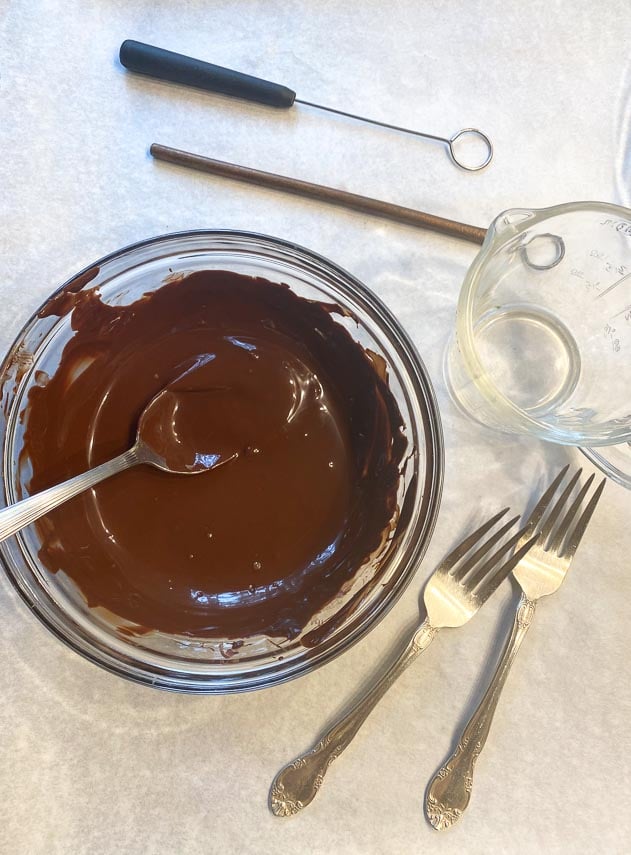
Try setting a heating pad on low and placing your container of tempered chocolate on top of it. Always keep checking the temperature keeping it within its range.
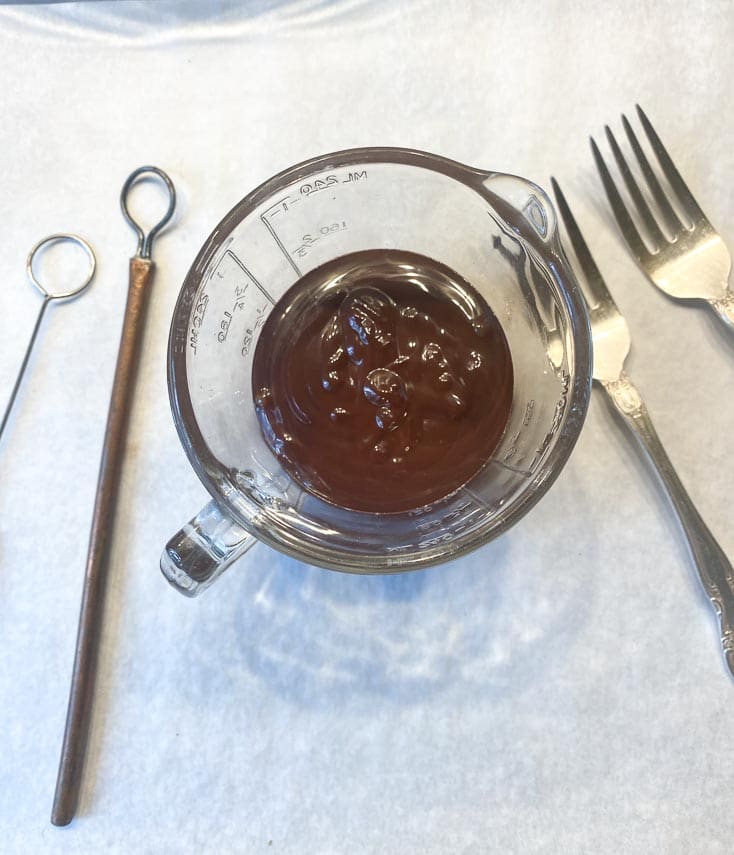
Stir it occasionally to keep the entire amount evenly heated as it will cool around the edges.
Drop a chilled ganache center into the tempered chocolate and allow it (and encourage it) to become completely submerged.
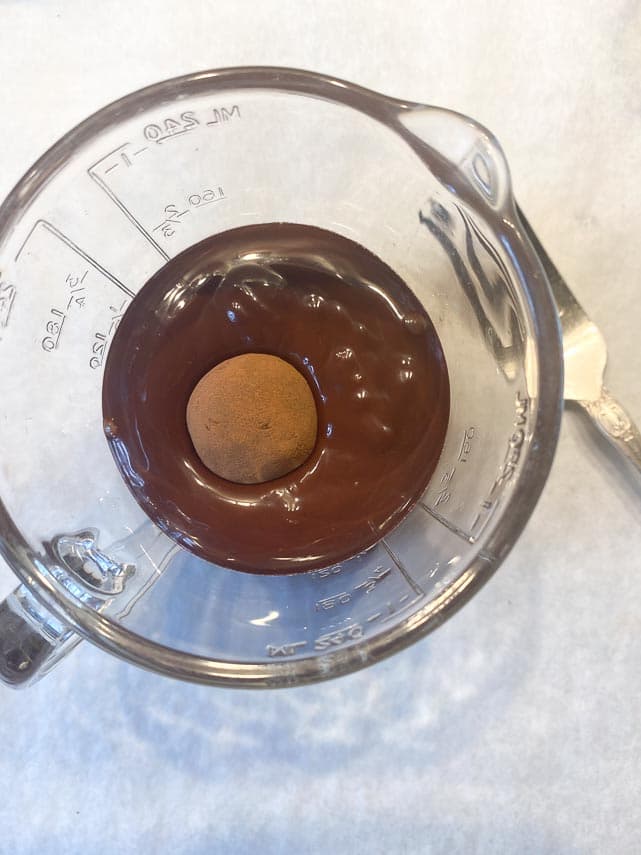
Use chocolate dipping tools or a couple of forks to lift the center out of the melted chocolate and shake it gently or toss it back and forth from tool to tool, to remove as much excess chocolate as possible.
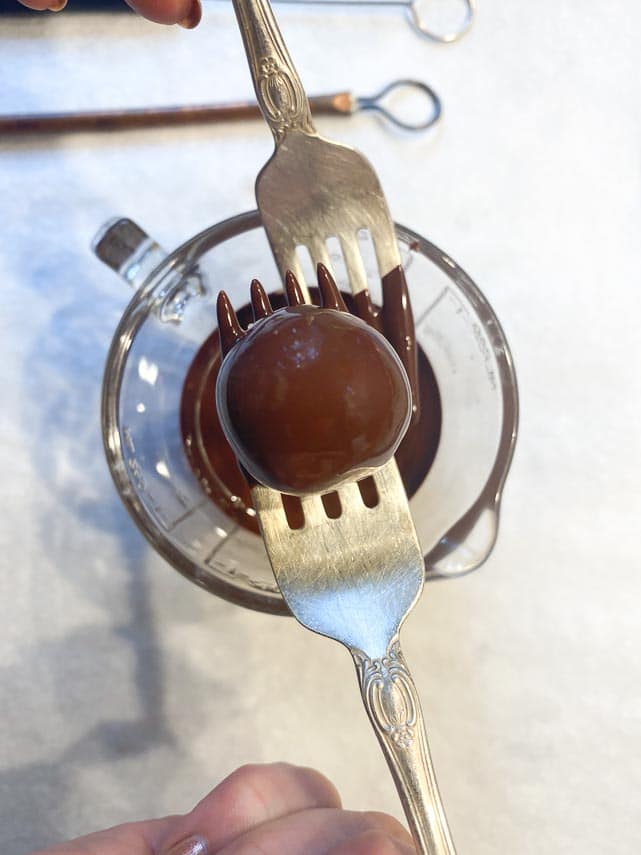
Make sure, however, that it is completely coated. If surplus chocolate is left on the truffle after dipping, it will accumulate around the base of the candies upon cooling, making what is called a “foot”, which is thick, unattractive and hard to crunch through! If a “foot” develops, you can try trimming it with a sharp paring knife after the truffle has firmed up. Repeat with all the centers, placing spaced apart on the pans.
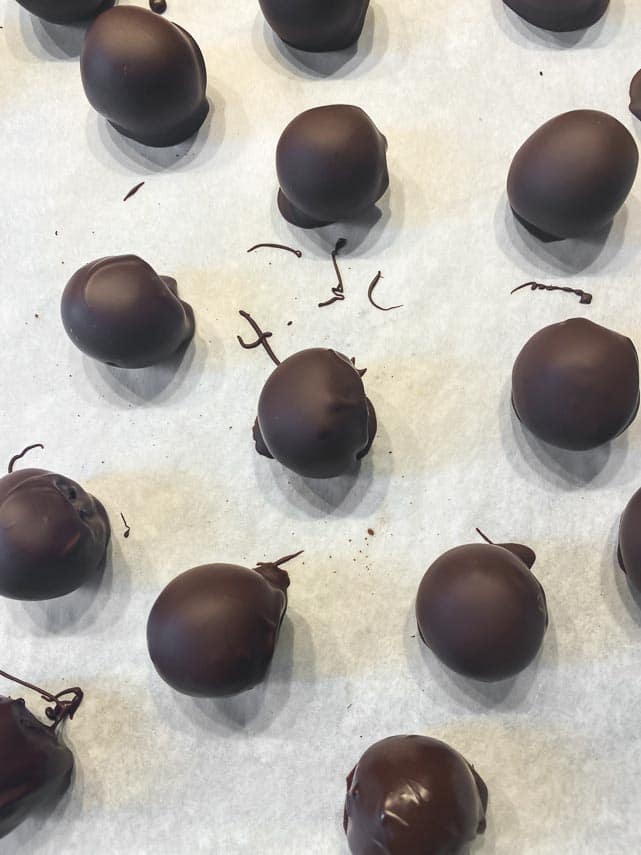
Allow the truffles to firm up; you may hasten this with a short time in the fridge. Place in fluted paper cups, if desired, and serve at room temperature. Truffles may be refrigerated in airtight containers for up to 1 week. (They can last longer but their delicacy lessens).
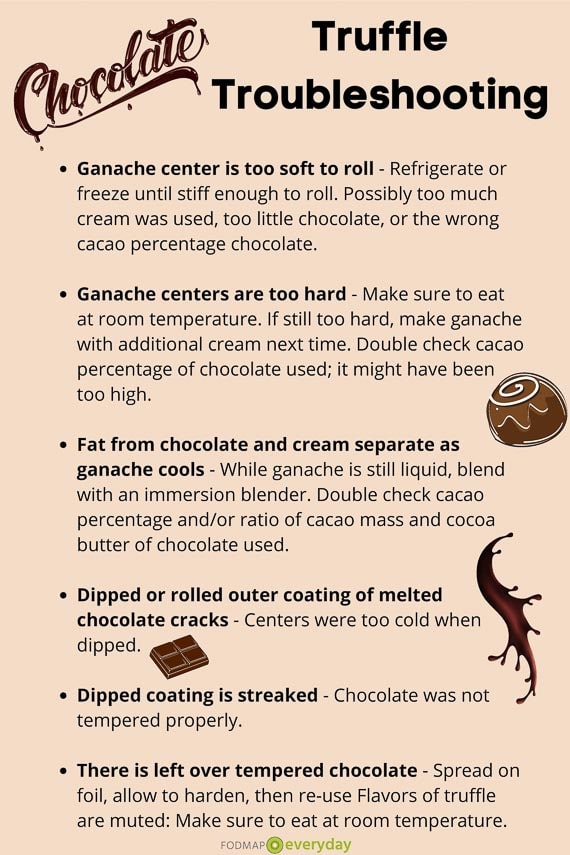
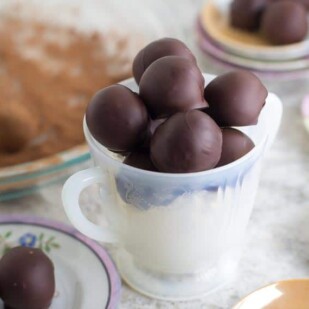
Low FODMAP Chocolate Dipped Truffles
Yes, you can enjoy truffles on the low FODMAP diet, and we can’t think of a more direct way to enjoy dark chocolate than with a couple of our Low FODMAP Chocolate Dipped Truffles. These truffles are rich and dark through and through from a silky ganache center to their crisp outer chocolate shell. For an easier version, check out our cocoa dusted Low FODMAP Dark Chocolate Truffles; these are a little fancier and require tempering.
Low FODMAP Serving Size Info: Makes about 90 truffles; 45 servings; serving size 2 truffles
Ingredients:
- 1 ¾ cups (420 ml) heavy cream; lactose-free if desired
- 2- pounds (910 g) bittersweet chocolate, preferably about 60% to 65% cacao, very finely chopped, divided
- Dutch-processed cocoa, sifted
- 90 small fluted paper cups, optional
Preparation:
-
Make the Ganache: Place cream in a large saucepan and heat over medium heat until cream just comes to a simmer. Remove from heat and immediately stir 1-pound (455 g) chocolate into the hot cream. Cover the pot and allow to sit for 5 minutes; the heat should melt the chocolate. Stir very gently until smooth, but so not whisk, which would add air.
-
Pour mixture into a shallow bowl (I use a pie plate); cover with plastic wrap and allow to cool at room temperature, preferably overnight, or until firm enough to roll. You may refrigerate this ganache until it is firm enough to roll, about 4 hours, to hasten the process. This is your ganache center mixture.
-
Coat your hands lightly with cocoa and roll chocolate ganache mixture into 3/4-inch to 1-inch (2 cm to 2.5 cm) balls, making them as round as possible. I like to use a small truffle scoop to facilitate. Chill in a covered container while you temper the remaining chocolate.
-
Temper the Remaining Chocolate: Line two rimmed half-sheet pan with aluminum foil, shiny side up, smoothing out any wrinkles.
-
Place about two-thirds of the remaining 1-pound (455 g) chocolate in the top of a double boiler with gently simmering water in the lower half of the double boiler. Stir gently to encourage melting, but not vigorously, which will add air. Do not allow chocolate to heat above 115°F (45°C) for. As soon as the chocolate is almost completely melted, remove from the heat and wipe the bottom of the pot to eliminate any chances of water droplets reaching the chocolate, which would cause it to seize.
-
Add about one-third of the remaining chopped chocolate and stir gently. The residual heat will melt it. You want to cool the chocolate down to 79°F (26°C). Keep adding the remaining chocolate, in a few more stages, if necessary, to cool chocolate further, continuing to stir gently until 79°F (26°C) is reached. Any un-melted chocolate can be removed and reserved for another use.
-
Place pot back over hot, not simmering water, and re-warm gently. Bring chocolate back up to 88°F to 90°F (31°C to 32°C). Do not allow any chocolate to rise above 90°F (32°C) or you will have to begin the entire tempering process again. Occasionally chocolate labels will tell you what their specific tempering temperature is, so heed their advice. The chocolate is now ready to use.
-
To test the temper, thinly spread a teaspoon amount on a piece of aluminum foil and allow it to cool. If your room temperature is warm, refrigerate it for about two minutes. The chocolate should look shiny and smooth and break with a crisp snap. Any dull spots or streaks, or a soft texture, indicate that the chocolate is not in good temper.
-
Now you must retain the chocolate’s temperature while you are working with it. Place the melted and tempered chocolate in a narrow, deep container. Try setting a heating pad on low and placing your container of tempered chocolate on top of it. Always keep checking the temperature keeping it within its range. Stir it occasionally to keep the entire amount evenly heated as it will cool around the edges.
-
Drop a chilled ganache center into the tempered chocolate and allow it (and encourage it) to become completely submerged. Use chocolate dipping tools or a couple of forks to lift the center out of the melted chocolate and shake it gently or toss it back and forth from tool to tool, to remove as much excess chocolate as possible. Make sure, however, that it is completely coated. If surplus chocolate is left on the truffle after dipping, it will accumulate around the base of the candies upon cooling, making what is called a “foot”, which is thick, unattractive and hard to crunch through! If a “foot” develops, you can try trimming it with a sharp paring knife after the truffle has firmed up. Repeat with all the centers, placing spaced apart on the pans. Allow the truffles to firm up; you may hasten this with a short time in the fridge. Place in fluted paper cups, if desired, and serve at room temperature. Truffles may be refrigerated in airtight containers for up to 1 week. (They can last longer but their delicacy lessens).
Notes:
Tips
• If you chop your chocolate finely enough, it should melt in the hot cream. If it does not, you can place the pan over very low heat and stir until melted; take care not to scorch the chocolate.
• You can create a whiskey-flavored truffle. Whiskey has been lab tested by Monash University. It is low FODMAP Green Light at a 30 ml serving size. Simply stir 1 to 2 tablespoons of whiskey into your finished ganache, depending on the strength you would like.
FODMAP Information
Our recipes are based on Monash University and FODMAP Friendly science.
- Chocolate: Monash University has lab tested dark, milk and white chocolate all have low FODMAP amounts: 85% dark at 20 g; dark at 30 g; milk at 20 g; white at 25 g.
- Dairy: The low FODMAP diet is not a dairy-free diet. It is, however, low in lactose. Many dairy ingredients are low in lactose, such as heavy cream and many cheeses.
Please always refer to the Monash University & FODMAP Friendly smartphone apps for the most up-to-date lab tested information. As always, your tolerance is what counts; please eat accordingly. The ultimate goal of the low FODMAP diet is to eat as broadly as possible, without triggering symptoms, for the healthiest microbiome.
Nutrition
All nutritional information is based on third-party calculations and should be considered estimates. Actual nutritional content will vary with brands used, measuring methods, portion sizes and more. For a more detailed explanation, please read our article Understanding The Nutrition Panel Within Our Recipes.
